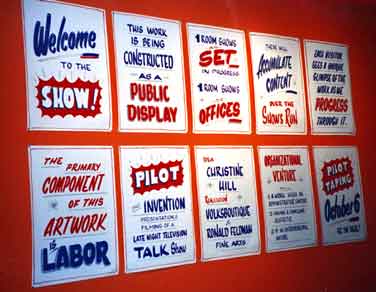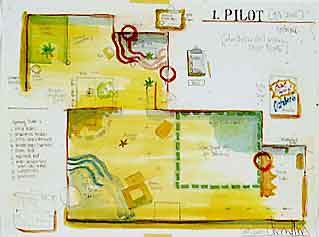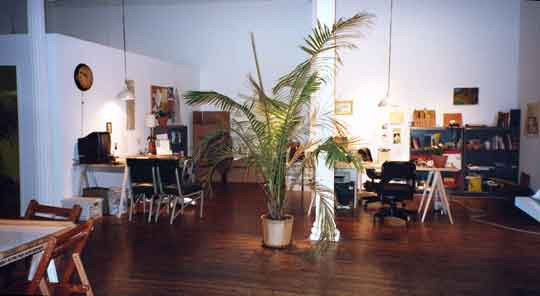
Christine Hill: Posters for "Pilot" in entrance
vestibule of Ronald Feldman Fine Arts.
Christine Hill: Pilotby Donald Goddard |
|
Across the street from Ronald Feldman Fine Arts
is a ground-floor business with windows facing the sidewalk that look into a
waiting area with chairs, reception desk, etc. It looks like it could be a gallery
or a store, or a gallery-store, it's not quite certain, like many businesses
in SoHo. The treatment of the street windows, the clock inside, the coffee table,
the display of recent (old) electronic machinery makes it seem like art, or a
place for art, but it's not (or maybe it is). At first I thought it was the lobby
for the Social Security office, which has a sign near the main door, but that
was some kind of displacement on my part. They are actually on the eighth floor.
This business at the street level, according to the receptionist, is devoted
to bringing old businesses up to date, cueing them into the internet and generally
making them more hip.
|
|
|
Christine Hill's approach is somewhat different, almost the opposite. What you see on the wall of Feldman's first space as you enter is a series of ten not-so-hip signs in the manner of colorful hand-painted signs announcing a sale or a special in a store along Broadway, middle or lower (which is not far away). The first one says, for instance, "Welcome TO THE SHOW," the sixth, "THE PRIMARY COMPONENT OF THIS ARTWORK IS LABOR," and the tenth, "PILOT TAPING October 6 SEE YOU HERE" (emphasis approximate). She is creating, producing a TV talk show, and for that reason has laid out the first big gallery space to accommodate a set for herself as host and her guests and a bank of bleachers for the audience. The second, smaller gallery space has Hill's production office, with a couple of desks and chairs for her and assistants, a conference table, and a green room, where guests are to be made up for camera when the show is taped on October 6. The audience, by invitation only, is to be chosen from gallery goers who drop their names in a box in the first gallery space. The show is a show, or will be. |
| At first there were signs indicating where things would be, and plans about what they might look like. Hung neatly on one wall are instructions and concepts on twelve clipboards assigned to Hill and various writers, set designers, photographers, etc. Hill sits at her desk most days and works with her assistants, deciding on and arranging for guests, devising sketches, discussing the set and the furniture, holding conferences not only with her assistants but occasionally with the gallery staff. During the last week of the exhibition, October 10-14, the final taping will be shown continuously in the environment of the completed set and office. In the meantime, things are accumulating. |
 Christine Hill: Floor Plan for Pilot Project. |
|
In an earlier work, Volksboutique (1996-97), Hill created and operated a second-hand clothing shop in the recently opened eastern sector of Berlin. In all respects, it seems to have been an ordinary shop where people bought clothes because they liked them and/or they were cheaper than new clothes. And so it was. But it was also a space, an entity invented and run by an artist, someone who had also been a masseuse and a band singer, among other things, that involved her in acquiring clothes, displaying and pricing them, conversing with customers, serving tea, etc. These were the materials of the work being done and the work being made, as it existed from moment to moment. Work within space and over time, representing time and space. It was also about the interaction of people assuming identities, their own and those of previous owners of the clothes, what they said and how that suited the clothes they were in, the people they were with, and the space they occupied in eastern Berlin. So the time span was something like thirty years or more, depending on whether you began with the space in the building or the clothes or the people. "Pilot" has a similar time span, though it is in some ways both more specific and more open-ended (toward continuing the past into the future). For my generation television was a futuristic enterprise. It is the most modern thing one could--and emblematically, at least, still can-- think of. I associate it with the 1939 World's Fair, and with its real emergence in the post-World War II years. For Hill's generation it's probably a rather dated medium, though powerful. The late night talk show goes back to the 1950s, to Jerry Lester, Jack Paar, and Steve Allen, and it hasn't really changed much since then. The host sits behind a desk and interviews guests seated next to him. Interviews are interspersed with sketches, musical numbers, and, of course, commercials. I think the introductory monologue by the host goes back that far as well, or at least to Johnny Carson. |
 Christine Hill: General View of Production Office. |
|
Even Hill's furniture is rather unmodern, unhip.
The host's desk for the show is a kind of standard '50s or '60s model--maybe
earlier. One segment--the remote--goes back even further. It involves Theodore
Roosevelt--his house, his barbershop, his bar, his importance to the life and
history of New York City. And the desk of the assistant who put together this
segment for the show has pictures of Roosevelt pinned to the wall, like family
photos, and lists of organizations to be contacted about him. Our forbear. Twentieth-century
man. The work devolves into history in a three-dimensional collage of useful
effluvia. Roosevelt is an icon of masculine omnipotence, which suffuses the history
of the talk-show forum, giving it its shape, as it does society in general, and
something to be reshaped. The idea is to make something that is very hard to
do--harmoniously and sequentially--seem easy to do, a natural outcome of things
the way they were meant to be. "Speak softly, and carry a big stick."
|
 Photo conference with Marc Nochella, Christine Hill, Dave Herman, Martina Batan, and Breck Hostetter (left to right). |
|
As in Hill's earlier Volksboutique, it is as though the past and present, constructed into a monument, will hold off the future. To be in the present is to be in the past as well. The future is often projected, and even lived, without a past. Hill addresses the fear of losing humanity with her insistence on human performance, interaction, work, and oddity. The gallery space is taken over by real, very clunky, carpentered objects--bleachers and the set for the host, in addition to all the stuff in the office. It's nothing like the ethereal TV image that will eventually by produced. It's rather mundane, limited in dimension and material to this space, whereas the image, the final product is in a sense infinitely spacious and everywhere, just as culture and realpolitik and religion are said to transcend, to exceed the consciences that produce them. This is the legendary Volk, but individual consciences still exist, gathered around that of the artist. Donald Goddard © 2000 |
|
The exhibition took place at t Ronald Feldman Fine Arts, 31 Mercer Street, New York, NY 10013 |
Art Reviews Listings - Previous Review - Next Review
Art Review - NewYorkArtWorld.com - NYAW.com All artwork is copyright of the respective owner or artist. All other material © Copyright 2015 New York Art World ®. All Rights Reserved.
New York Art World ® - Back to Top